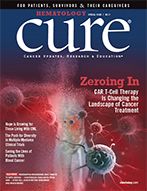Debunking the Myths of Stem Cell Donation
Just one person can make a difference for patients with blood cancer.
DKMS HAS A CLEAR MISSION: delete blood cancer. Founded just over 25 years ago, in Germany, the organization was created by Peter Harf, Ph.D., in an effort to save his wife, Mechtild, who had been diagnosed with leukemia. At the time, there were only about 3,000 potential stem cell donors in Germany. None of Mechtild’s siblings was a match, so she needed an unrelated donor. Unfortunately, that did not happen in time for her. But her death was not in vain. DKMS has registered more than 7 million potential donors and provided more than 60,000 transplants worldwide. The organization has expanded with offices in the United States, the United Kingdom, Poland and India.
How does the donor registry work?
CURE® spoke with James Kirkland, content strategist for DKMS (and registered donor himself), about donor myths and what the process entails.Kirkland: The registry is a list of people who are simply saying that they are ready, able and willing, if ever needed. I think that’s one of the major misconceptions that people have about the registry. They think when you sign up, you are donating then and there, or you have to schedule the donation. I’ve had people actually ask, “Do you take the bones here?” Which is wrong on so many levels.
The registry is a community effort to empower individuals who have no necessary connection to the medical community. Also, to connect them to patients in need, based on the unique qualities of human leukocyte antigen typing, which can be looked at as genetic factors that are specific to you.
What are some of the biggest myths that you will find?
Mainly, we dispel myths, while also raising awareness about this great cause by actively asking people to register at physical drives across the country. Then, we help to facilitate those transplants and are available, so that when a patient finds a match, they contact us and we work with that donor individually.The biggest obstacle we have is that people don’t know that you can even do this, that it’s voluntary, that you can sign up and, potentially, save a life. But the people who do know, they usually have a very skewed understanding of it, something that tends to be much more suited for Hollywood productions. We’ve seen on TV where someone is getting bone marrow extracted, without anesthesia, for a person that they know. That’s not how this works.
People think it’s a very laborious process. But, 75 to 80 percent of all donations are made through a method called peripheral blood stem cell (PBSC), which is similar to blood platelet or plasma donation.
People equate it to blood donation, so they think there’s somebody else out there who can do this. It’s not something someone else can do.
Aside from PBSC, there is another method. How does that work?
You are, potentially, the only match for this person. I think there’s no greater way to highlight your uniqueness, biologically, and your uniqueness as a person, than to be able to say, “I matched this person and when the time came, when that call came down, I said ‘yes.’ I made the difference in their life.” Bone marrow donation is far, far less intensive than people think. The extraction from the pelvic bone is an outpatient procedure, so you go in for an hour or so, you’re under anesthesia and you’ll leave the hospital. However, there is usually pain or soreness in the iliac bone for days, maybe even weeks.
There is a cost to register. What if a donor can't afford that?
I’ve seen stories of people running a 5K two weeks after the procedure. We’re not encouraging you to do that — we think you should take your proper rest — but the idea of what it does to your body and the effect it has on you physically has been dispelled just by the number of examples that pop up.That’s one of the things that we always kept as key to our organization: there should never be a moment when we have someone who is ready and willing to donate and is a match, but can’t go on because they don’t have the $65 to cover the cost. We do the fundraisers, the events and we solicit private donations.
How do the donor-patient meetings work?
We cover the cost of everything, the insurance of the patient covers the transplant itself. This process doesn’t cost you anything.The amount of stories that are out there can be used as a powerful way to explain to people why this is such an incredible thing to do. Each story is unique — you hear the story of the donor and you hear the story of the patient. You are saving a person, an individual, an entire life with a connection to family and friends and community. It’s one of the most powerful, straightforward ways to explain why you should donate.

Patrick Swayze’s Widow Reflects His Cancer, Demi Moore Speaks About Breast Cancer and More
April 12th 2024From Patrick Swayze’s widow recalling his pancreatic cancer diagnosis to Demi Moore speaking about her aunt’s courage during cancer, here’s what’s going on in the oncology space this week.
Read More